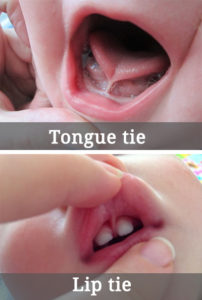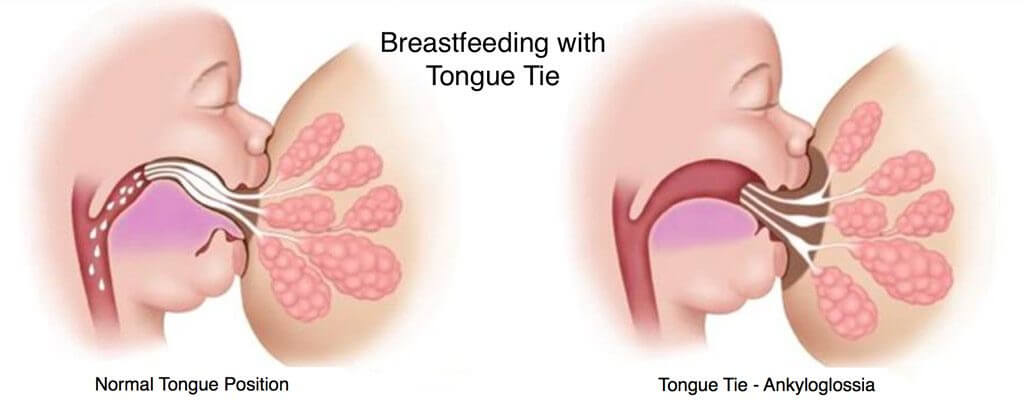 Tongue and lip ties (medically known as ankyloglossia) can lead to serious complications in infants, adolescents, and even into adulthood if left untreated.
Tongue and lip ties (medically known as ankyloglossia) can lead to serious complications in infants, adolescents, and even into adulthood if left untreated.
What is a tongue tie?
Tongue ties are caused when the lingual frenulum (the membrane which connects the tongue to the floor of the mouth) is thick, short, or otherwise malformed, restricting the tongue from moving correctly.
What is a lip tie?
A lip tie is when the frenulum band of tissue that connects the upper lip to the gum is thick, short, or inelastic, restricting the lip from moving.
What are the issues associated with tongue tie and lip tie?
For infants, tongue tie or lip tie may mean unsuccessful breastfeeding or bottle feeding

For infants born with tongue or lip tie, the restriction does not allow the lip to rest passively for proper suctioning.
Symptoms you may notice can include:
- Difficulty latching or staying on latch
- Excessive gas or burps
- Gagging and choking
- Milk dribbles
- Reflux/colic
- Excessive spitting up
- An arched back due to discomfort
- Falling asleep at the breast
- Long feeding times or continual feeding
- Lip calluses or blisters
- Swallowing air
- Chomping on the nipple
- Can only feed during letdown
- Tucking of the upper lip
- Fussing/fighting at the breast
- Acts tense while nursing
- Sensitive gag reflex
- “Lazy Eater”
- Difficulty holding a pacifier
- Failure to gain weight
For nursing mothers, tongue tie or lip tie may mean difficult or painful breastfeeding
Tongue and lip ties don’t only affect the infant. A baby’s tethered oral tissue can also cause physical and emotional issues for a breastfeeding mom, which could include:
- Painful, shallow latch
- Distorted, sore, damaged, and/or bleeding nipples
- Plugged ducts
- Mastitis
- Feelings of failure or disappointment
- Loss of milk supply (especially after 3 months)
- Nipple throbbing (vasospasm)
For older babies and toddlers, tongue tie or lip tie may cause difficulty eating solid foods
Tongue and lip tie symptoms in older babies and toddlers may include:
- Eating slowly (often the last one to finish a meal)
- Very picky about food, especially textures
- Choking when transitioning to solid foods
- Gagging or spitting food out
- Refusing to wean
- Difficulty swallowing
- Easily distracted during mealtimes
- Grazing on food throughout the day
- Failure to gain weight
If left untreated, the problematic side effects of tongue and lip tie continue into adolescence and adulthood.
For children, tongue tie or lip tie may cause difficulties with speech
Tongue tie or lip tie related speech disorders may include such symptoms:
- Trouble articulating sounds (- l, r, t, d, n, th, sh, and z)
- V-shaped notch at the tip of the tongue
- Inability to stick out the tongue past the upper gums
- Inability to touch the roof of the mouth
- Difficulty moving the tongue from side to side
For children and adults, tongue tie or lip tie may cause undesired aesthetic effects
Tongue ties may prevent the proper skeletal development of the upper jaw bone causing crowded teeth. Lip ties can cause undesired spaces or gaps between teeth. If a lip tie is not corrected, orthodontic treatment may be required to correct the placement of teeth. Also, a lip tie correction may be advised by your orthodontic provider to aid in the correction and longevity of teeth placement.
For children and adults, tongue tie may cause breathing disorders
Just as a tongue tie can cause undesired gaps and crowding, it can also be the cause of breathing disorders. Sleep apnea and other breathing problems may be the result of a tongue tie preventing the proper skeletal development of the upper jaw bone and palate.
Hoffman Dental Care is excited to offer an effective and painless solution
Dr. Michael Hoffman is trained to perform laser frenectomies using a Solea laser. A frenotomy, or laser lip or tongue-tie release, is the laser removal of a frenulum, the small fold of tissue that prevents part of the body from moving too far.
The incredible CO2 Laser technology allows Dr. Hoffman to safely and efficiently perform the minimally invasive procedure with predictable and instant results. There is little-to-no bleeding, no sedation needed, and little-to-no pain.
The procedure is relatively fast.
The procedure may be performed as early as a couple of days post-partum and can also be performed into adulthood.
Typically, once a problem with a tongue-tie or lip-tie has been discovered, the sooner it is addressed the better the procedure will work and the fewer issues the child will have.
Frenectomy Aftercare Instructions
Your goal is to have the frenum heal and re-form as far back as possible. Proper stretches during the healing process help to ensure that.
Stretches: Begin doing the stretches the day after the procedure. You should do the stretches with the baby lying down in your lap, and head towards you like your baby was in the doctor’s lap during the exam. Gloves (preferred) or clean fingers with nails neatly trimmed should be used for stretches.
Stretching Instructions:
- Lip: If the lip was revised, first put your fingers all the way into the fold of the lip and pull the lip up and out as high as possible, so you can see the white diamond and cover the nostrils. Hold for 5 seconds. It may bleed slightly the first day or two; this is not a concern.
- Tongue: with one or two fingers, lift the tongue up and back just above the white diamond to put tension on the wound and hold for 5 seconds. It may bleed slightly for the first day or two; this is not a concern.
- The main goal is to “open the diamond” all the way up on the lip and tongue. If you notice that it is becoming tight, then stretch it a little more to open it back up.
- Repeat these stretches a minimum of 5 times a day. It is okay to not do the stretches at night.
- Repeat this for 3 weeks
- The release area will form a wet scab after the first day. It will appear white and soft. It may change color to yellow or even green. This is not an infection, but a scab in the mouth as it is healing. This is normal. The white/yellow area will get smaller each day lengthwise, while healing is still happening. Even though the white scab will heal, you must continue stretching or the new frenum will not be as long as possible and the surgery may need to be repeated. Mild swelling is normal within the first few weeks.
Pain medication:
Please check with your pediatrician for proper dosing of Infant or Children’s Tylenol or Motrin. This may be needed for the first few days.
Follow Up:
Follow-up with a lactation consultant is recommended if nursing. Bottle-feeding babies will benefit from visiting a feeding specialist or your pediatrician. A consult with a body worker, such as a chiropractor or craniosacral therapist, is also very helpful. Feeding should improve with each day. Sometimes there is an immediate difference in feeding, and sometimes it takes a few days. Your baby needs to learn to adjust to the new mobility of their lip and tongue.
No follow-up visit with our office is necessary. Should you have any questions or concerns, please contact our office during normal business hours (586) 247-8730 or call Dr. Hoffman after hours.



